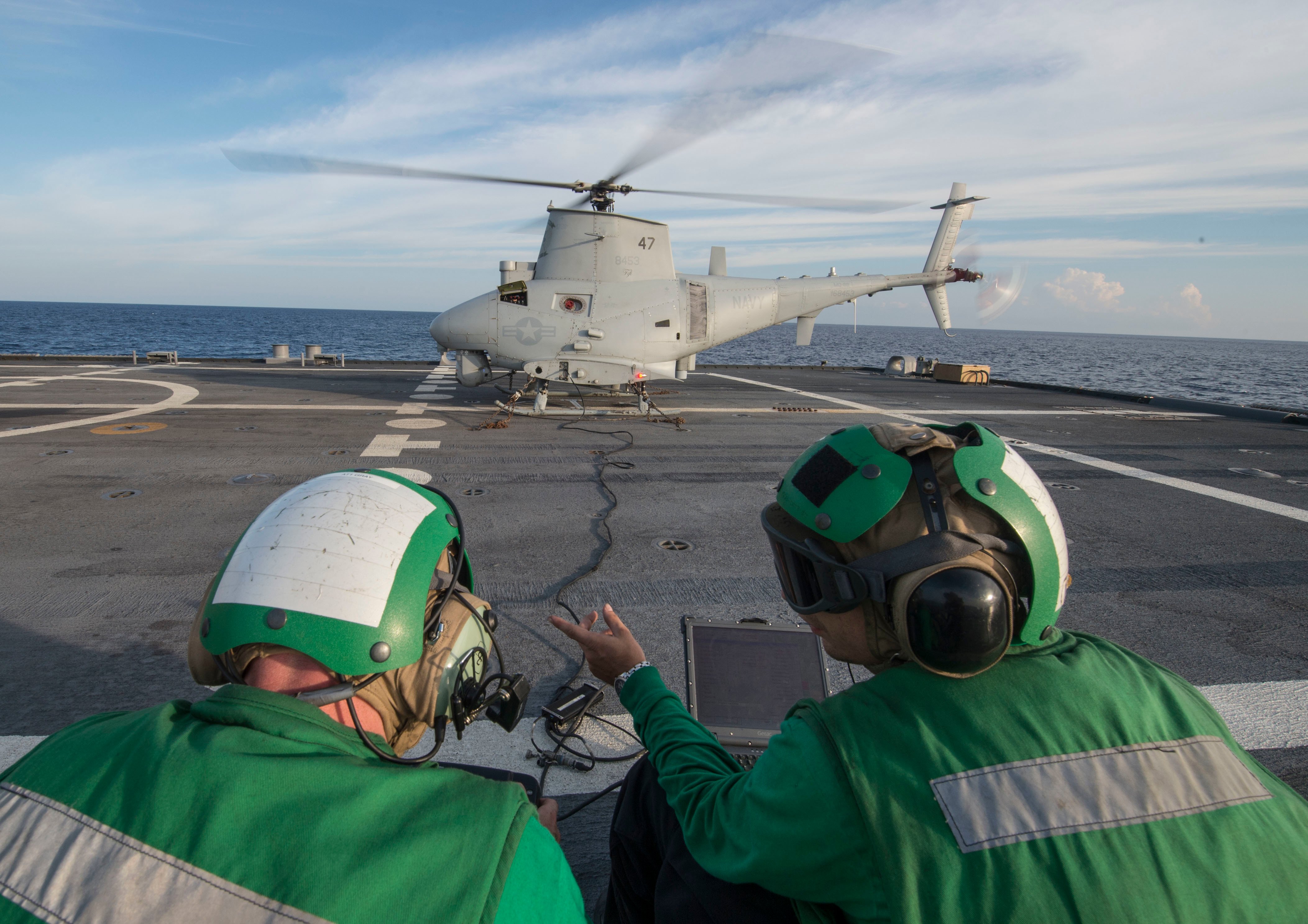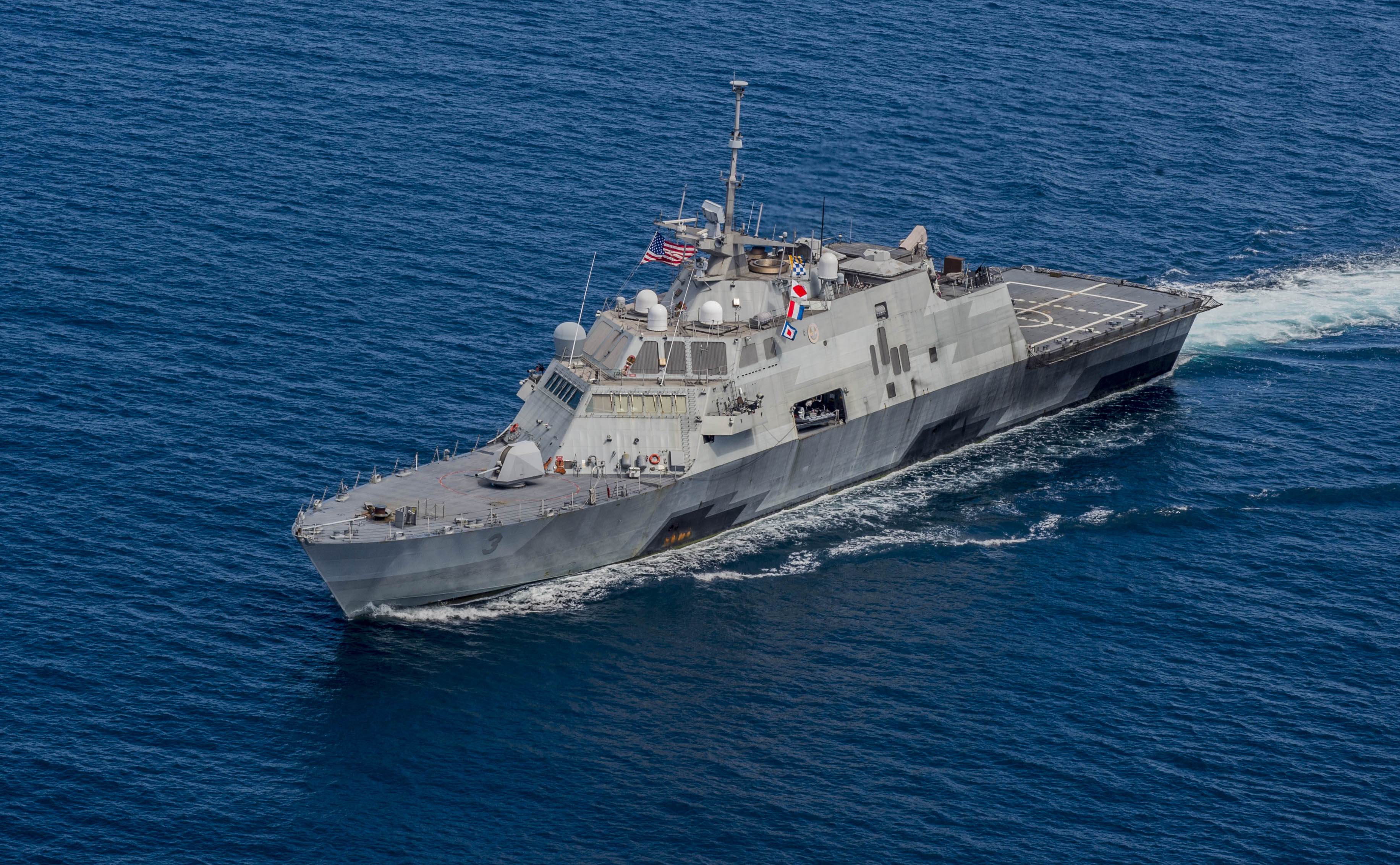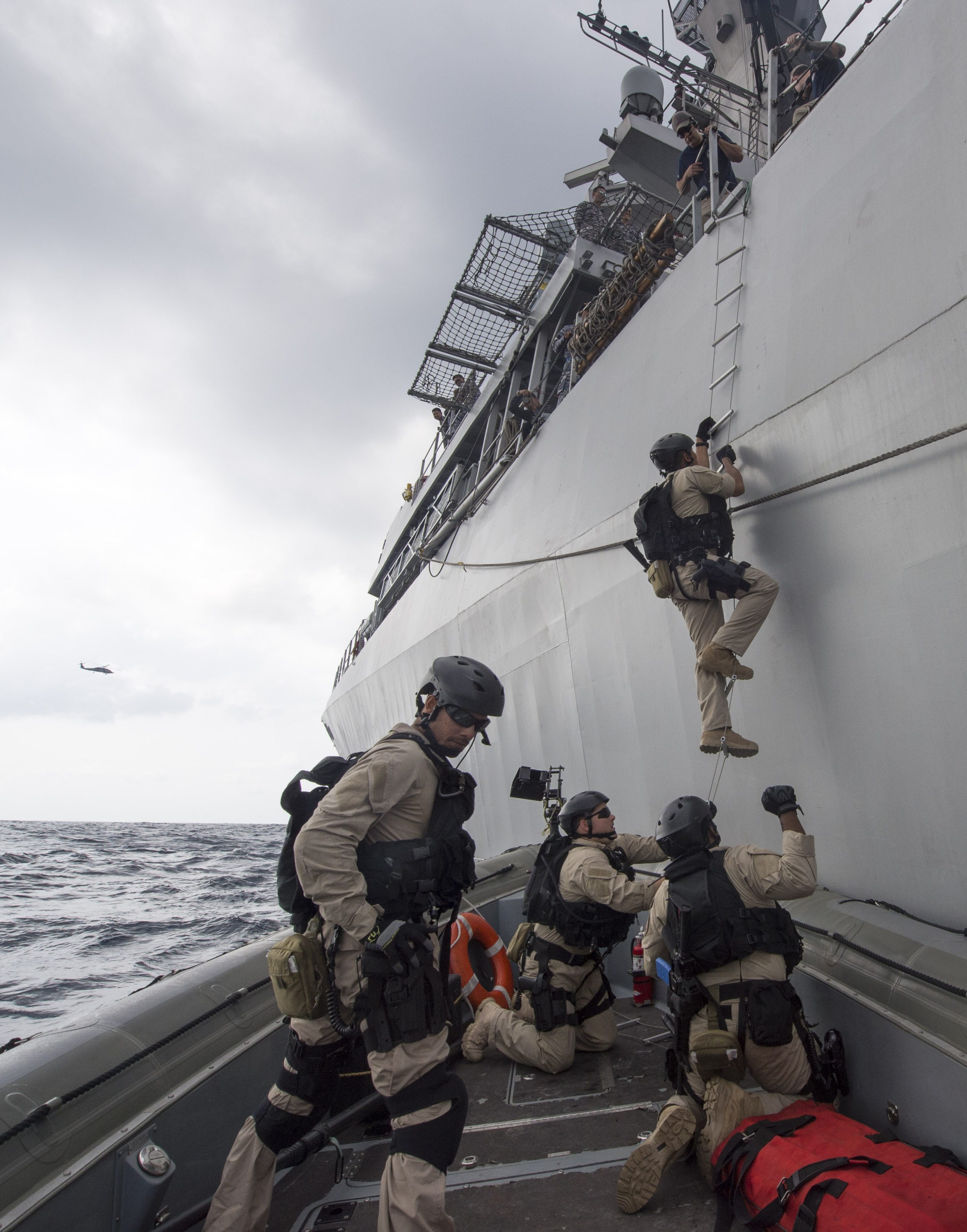
The Navy’s summer series of bilateral exercises in the Pacific gave the Littoral Combat Ship USS Fort Worth (LCS-3) a chance to demonstrate emerging capabilities of the new platform, using its rigid-hull inflatable boats (RHIBs) and unmanned aerial vehicles (UAVs) for the first time in an operational context.
Cmdr. Christopher Brown, Fort Worth’s commanding officer, told USNI News in an email that Cooperation Afloat Readiness and Training (CARAT) Indonesia and CARAT Singapore were particularly good exercises for the ship’s crew, which were able to integrate all the assets of the LCS surface warfare mission package: one MH-60R helicopter, one MQ-8B Fire Scout unmanned aircraft system, two 11-meter RHIBs with two six-man boarding teams and two 30mm guns.
“This is the first time that Fire Scout is operating in 7th Fleet onboard Fort Worth and also the first time that Fire Scout and the MH-60R helicopter have deployed together onboard an LCS. The addition of Fire Scout greatly expands the ship’s aviation capabilities and endurance, and provides a dedicated asset for maritime domain awareness,” he wrote.
“During CARAT Singapore, Fire Scout was used to provide over-the-horizon imagery and video of the opposing surface action group and stream the video back to Fort Worth. This capability provided Fort Worth a detailed visual of the opposing ships that a radar picture alone can’t provide. Additionally, the MQ-8B provides longer on-station times and is less counter-detectable than the MH-60R.”
Brown said the use of UAVs – both the Fire Scout and the Republic of Singapore Navy’s Scan Eagle – was the highlight of CARAT Singapore, “demonstrating the value of unmanned platforms in providing an enhanced maritime domain awareness picture for the afloat task group.”
The LCS crew has also tested and integrated a Fire Scout mission payload called VORTEX, which streams video from a Brite Star II Forward-looking Infared (FLIR) camera to a handheld panel. Brown said VORTEX provides units – such as a Visit, Board, Search and Seizure (VBSS) team on an 11-meter RHIB – the ability to see what Fire Scout is seeing over land or sea.
The VBSS team played a big role in CARAT Indonesia, Brown said, with the Indonesian Navy coming aboard Fort Worth for the first time.
“Defensive positioning, search procedures, and weapons tactics were discussed and participants were able to utilize the techniques during a realistic boarding by the Indonesian Navy (TNI-AL) boarding team onboard Fort Worth,” Brown wrote.

Fort Worth’s success this summer – and in the first nine months of its 16-month deployment – comes after a less productive maiden deployment for the class. USS Freedom (LCS-1) deployed from March to December 2013, and while the proof-of-concept deployment succeeded in showing the utility of the smaller ship class, the ship itself spent much more time waylaid by maintenance problems than expected.
During the first 180 days of Freedom’s deployment, the ship was underway only 51 days, lost 21 planned underway days due to maintenance needs and required about 12,000 man-hours of corrective maintenance. Fort Worth, in contrast, spent 96 days underway in its first 180 days of deployment – a full week longer than had been scheduled – and only required about 3,900 man-hours of corrective maintenance.

Brown attributed part of the improvement to the speed in which the shore-based support system can respond when repairs are needed. He explained that the LCS has both preventive maintenance availabilities – about five days long and scheduled every four to six weeks – in which U.S.-based contractors are flown to Singapore to carry out maintenance checks on the ship’s systems. The ship also has repair availabilities, which last two weeks and are scheduled every four months.
Brown said there was no particular system or component driving maintenance needs, but he said that the shore system has been able to respond very quickly when needed.
“During Fort Worth‘s last preventive maintenance availability, contractors discovered an unserviceable component on the ship’s ready life boat davit. Within 48 hours of discovery the faulty component was sourced, procured, installed and operationally tested, enabling Fort Worth to meet minimum operational equipment required for setting sail in support of CARAT Indonesia 2015,” he wrote.

For Capt. H.B. Le, who earlier this month took over as commodore of Destroyer Squadron 7 – which includes Fort Worth – that ability to take care of maintenance needs quickly and in a flexible timeline means having more options for how to use his ship.
“A greater time between maintenance periods allows Fort Worth the opportunity to respond quickly to a variety of regional contingencies. For example, the January 2015 repair availability maintenance period was moved three weeks to the right, allowing Fort Worth to provide support in the search for [missing airliner] Air Asia Flight 8501. Fort Worth was also able to conduct a planned maintenance availability (PMAV) in Sasebo, Japan. While Singapore will remain the primary port for LCS maintenance and logistics, this expeditionary maintenance concept allows Fort Worth to operate for longer periods of time throughout South and Southeast Asia,” Le told USNI News in an email.
“This region of the world has been impacted by earthquakes, tsunamis, floods, and other natural disasters far too often recently. Having a ship like Fort Worth in the region, which has demonstrated flexibility in required maintenance schedules, allows us to respond quickly and effectively to a wide-array of humanitarian aid and disaster relief situations. We have the ability to be first on the scene and can provide immediate support when necessary.”
Le, who served as deputy commodore of DESRON 7 from January until his promotion this month, praised the flexibility of the support system to reschedule, rather than cancel, maintenance availabilities if the 7th Fleet needs the LCS to continue operating. In other communities in the Navy, staying out on deployment longer means returning to homeport late, missing maintenance availabilities and having to be squeezed back into a tight and complex maintenance schedule.
For now, the shore support in Singapore is only responsible for maintaining the one LCS, but Le said he doesn’t expect problems in a few years when more LCSs operate in theater simultaneously.
“I don’t want to speculate on future operations, but having more LCSs in theater will also bring more support from the shore side,” he said. “I have no reason to expect shore support to be anything less than outstanding in the future, just like it has been to date.”
Overall, Le said the Fort Worth deployment has shown the LCSs are “highly capable ships” that can respond to diverse mission sets.
“A major benefit of the LCS is that it’s of comparable size to regional warships that patrol Southeast Asia, allowing us to operate hull-to-hull with these navies during exercises and operations,” he wrote.
“The LCS ship class also has a shallow draft and can operate at high speeds, allowing access and the ability to provide presence in places in Southeast Asia that larger U.S. navy ships simply cannot go. Fort Worth can cover a larger area in less time, and get closer to land than other larger ships in the fleet, making it the ideal ship for tasking when events like the search for the missing Air Asia Flight 8501 occur.”





